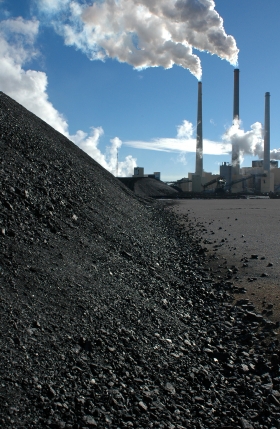The coal industry got a lot of goodies in the House-passed energy and climate bill, but it’s pressing for even more in the Senate version.
At a Senate hearing on the future of coal hosted earlier this week by Sens. Tom Carper (D-Del.) and George Voinovich (R-Ohio), representatives from utilities and coal companies told lawmakers what they want out of climate and energy legislation: more handouts and looser standards.
Coal boosters have long argued that “clean coal” technology — carbon capture and sequestration (CCS) — is just around the corner (despite plenty of arguments to the contrary). Says the American Coalition for Clean Coal Electricity on its website, “The technology isn’t 20 years away—some of it is here today.”
But at the hearing on Wednesday, industry reps argued that CCS is still more than a decade from viability and therefore a climate bill shouldn’t demand too many emissions cuts too soon.
“I don’t think CCS will be widely deployed until 2020 or after,” said Chris Hobson, senior vice president of research and environmental affairs at Southern Company, the fourth largest utility company in the U.S. The House bill, he said, includes “targets and timetables that are in advance of the [industry’s] abilities.” He called for a lowering of the bill’s near-term emissions targets, which currently require a 17 percent cut below 2005 levels by 2020.
Hobson also said that Southern wants to see an upper limit on the price of carbon (often called a “safety valve” or “off-ramp” that would kick in if the price hits a certain level), and said the free allocation of pollution permits should be phased out more slowly than in the House bill.
Steve Winberg, vice president of research and development at CONSOL Energy Inc., a major coal producer, echoed those points. CCS “won’t be deployed to sufficient extent by 2020,” he said. He argued that the House bill is the “wrong template” to use, and the Senate should take its time crafting legislation to account for the “enormous shortcomings” of the House bill.
The fact that CCS is far from ready for prime time is all the more reason for it to get much more government funding, the industry reps reason. They say the House bill doesn’t provide enough support for CCS, even though it designates $60 billion for research and development of the technology, in addition to $1 billion per year for CCS demonstration and deployment, funded by a fee on consumers of fossil-based electricity. The House bill would also reward early movers on CCS with bonus emission permits.
But at the hearing, the industry reps said they want more money to develop and deploy large-scale CCS projects in the near term, more money for longer-term pilot projects, more money to explore potential sites for CCS, and more money for the construction of piping systems to transport carbon dioxide to storage sites.
Granted, some important players in the coal sector are generally supportive of the House bill. United Mine Workers of America spokesperson Phil Smith said last month, “the amount of money dedicated to coal in [the Waxman-Markey] bill is remarkable, and the future of coal will be intact.” Duke Energy and Alstom (which was also represented at this week’s hearing) are both members of the U.S. Climate Action Partnership, which helped craft the House bill. Rep. Rick Boucher (D-Va.), who led the charge to get coal-friendly provisions into the House bill, proudly declared that the legislation would lead to “increased coal use” once CCS technology is in wide use.
But Wednesday’s hearing made it clear that powerful coal producers and users are at least as determined as environmental advocates to get a better deal from the Senate than they did from the House.



